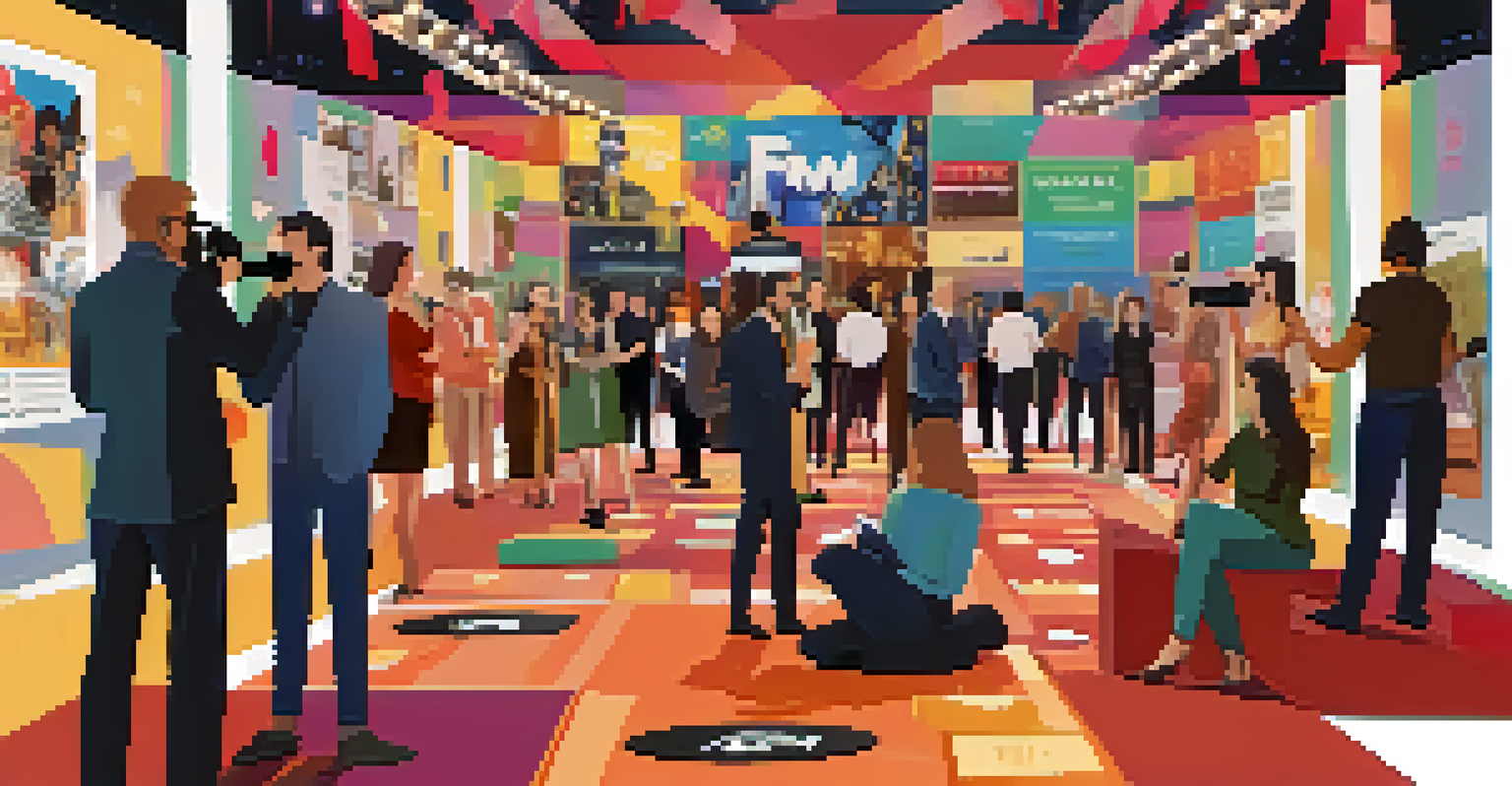The Future of Film Festivals in a Digital Age

The Shift to Virtual Platforms for Film Festivals
In recent years, film festivals have embraced virtual platforms, allowing filmmakers and audiences to connect from anywhere in the world. This shift has opened doors for many emerging artists who may not have had the opportunity to showcase their work at traditional festivals. The convenience of streaming films online means that viewers can watch films on their own schedule, making festivals more accessible than ever before.
Film festivals are a celebration of the art of cinema, but they are also a platform for dialogue, discovery, and community engagement.
However, this change also presents challenges, such as the potential loss of the communal experience that comes with in-person screenings. There's something special about watching a film with a crowd, sharing gasps, laughs, and applause that simply can't be replicated through a screen. As festivals move online, organizers are finding creative ways to foster engagement and community, such as hosting live Q&A sessions and virtual networking events.
Ultimately, the future of film festivals will likely involve a hybrid model that combines the best of both worlds. By integrating in-person events with online components, festivals can reach a wider audience while still preserving the magic of the cinema experience.
How Technology is Enhancing Film Festival Experiences
Advancements in technology are transforming how films are presented and experienced at festivals. From immersive virtual reality (VR) experiences to stunning 4K screenings, filmmakers can now showcase their work in innovative ways. This not only enhances the viewing experience but also allows filmmakers to push the boundaries of storytelling.

For instance, VR installations at festivals like Sundance have captivated audiences, offering them an opportunity to step into the story in a way traditional films cannot. These technologies create a deeper emotional connection, immersing viewers in the narrative. As audiences become more tech-savvy, they’ll likely seek out these unique experiences during film festivals.
Virtual Platforms Expand Access
Film festivals are increasingly using virtual platforms to connect filmmakers and audiences worldwide, enhancing accessibility and opportunities for emerging artists.
Moreover, technology enables filmmakers to gather real-time feedback during screenings, a valuable tool for refining their work. By leveraging data analytics, filmmakers can understand audience reactions and adjust their projects accordingly, ensuring that their films resonate with viewers.
The Role of Social Media in Film Festival Promotion
Social media has become an essential tool for film festivals, allowing them to reach broader audiences and engage with fans directly. Platforms like Instagram, Twitter, and TikTok enable festivals to share highlights, trailers, and behind-the-scenes content, generating buzz around upcoming films. This instant access helps create a sense of community and excitement among audiences.
Diversity is being invited to the party; inclusion is being asked to dance.
Additionally, filmmakers use social media to promote their projects, share personal stories, and connect with fans and fellow creators. A well-crafted social media strategy can elevate a film's visibility, making it more likely to attract attention during festivals. The interactive nature of these platforms encourages discussions and motivates audiences to participate in festival events.
As festivals continue to evolve, the integration of social media will play a crucial role in shaping their identity. By fostering genuine connections with audiences, festivals can enhance their relevance and ensure that their events remain memorable.
The Importance of Diversity and Inclusion in Film Festivals
Diversity and inclusion have become paramount in the film industry, and film festivals are no exception. Festivals are increasingly prioritizing representation, showcasing films from underrepresented voices and highlighting stories that reflect the rich tapestry of human experience. This shift not only enriches the festival lineup but also resonates with audiences looking for authentic narratives.
Many festivals now offer specific categories or awards for films by women, people of color, and LGBTQ+ creators. By doing so, they encourage filmmakers from diverse backgrounds to share their unique perspectives, fostering a more inclusive environment. This focus on diversity not only enhances the festival experience but also challenges the traditional narratives often seen in mainstream cinema.
Tech Innovations Transform Viewing
Advancements in technology, such as VR and data analytics, are revolutionizing how films are presented and experienced at festivals, creating deeper emotional connections with audiences.
As we move forward, film festivals that embrace diversity and inclusion will likely thrive, attracting audiences who value authenticity and representation. By amplifying underrepresented voices, festivals can inspire meaningful conversations and drive change within the industry.
Environmental Sustainability in Film Festivals
As the world becomes more conscious of environmental issues, film festivals are also taking steps towards sustainability. Many festivals are now implementing eco-friendly practices, such as reducing single-use plastics, offering digital tickets, and promoting public transportation options for attendees. These initiatives not only minimize the carbon footprint but also set an example for other events in the industry.
Moreover, some festivals are curating films that address environmental themes, using their platform to raise awareness about climate change and sustainability. By featuring documentaries and narratives that explore these critical issues, festivals can engage audiences in meaningful discussions about their impact on the planet. This creates a dual benefit of entertainment and education.
As we look to the future, the commitment to sustainability will likely become a defining characteristic of successful film festivals. By prioritizing eco-friendly practices and promoting environmental awareness, festivals can attract a growing demographic that values sustainability.
Networking Opportunities in a Digital Landscape
Networking has always been a vital component of film festivals, allowing filmmakers, industry professionals, and audiences to connect and collaborate. In the digital age, festivals are finding new ways to facilitate networking through virtual events, workshops, and online forums. This evolution enables participants to engage with a wider range of people, breaking down geographical barriers.
Many festivals are now offering dedicated online networking sessions where filmmakers can pitch their projects to potential investors or collaborators. These virtual meetups provide an invaluable opportunity for filmmakers to gain insights, feedback, and even funding. The convenience of online networking allows participants to connect with industry leaders they may not have met otherwise.
Diversity and Sustainability Matter
Film festivals are prioritizing diversity and environmental sustainability, showcasing underrepresented voices and implementing eco-friendly practices to attract conscious audiences.
As technology continues to evolve, the potential for networking will expand, making it easier for creative minds to come together. This digital landscape will foster innovative collaborations and partnerships that could shape the future of the film industry.
The Future of Film Festival Formats and Programming
With the rise of digital platforms, film festivals are rethinking their formats and programming strategies. Traditional multi-day events are now complemented by year-round programming, allowing audiences to engage with films and filmmakers outside the festival's typical timeframe. This approach keeps the excitement alive and encourages continuous audience engagement.
Additionally, festivals are experimenting with shorter formats, such as weekend showcases or thematic screenings, catering to diverse audience preferences. By offering flexible programming options, festivals can attract new viewers while still satisfying loyal fans. This adaptability ensures that festivals remain relevant and appealing in a fast-paced digital world.

Looking ahead, the ability to pivot and innovate will be crucial for the survival of film festivals. As technology and audience expectations evolve, festivals that embrace change will continue to thrive, providing enriching experiences for filmmakers and viewers alike.